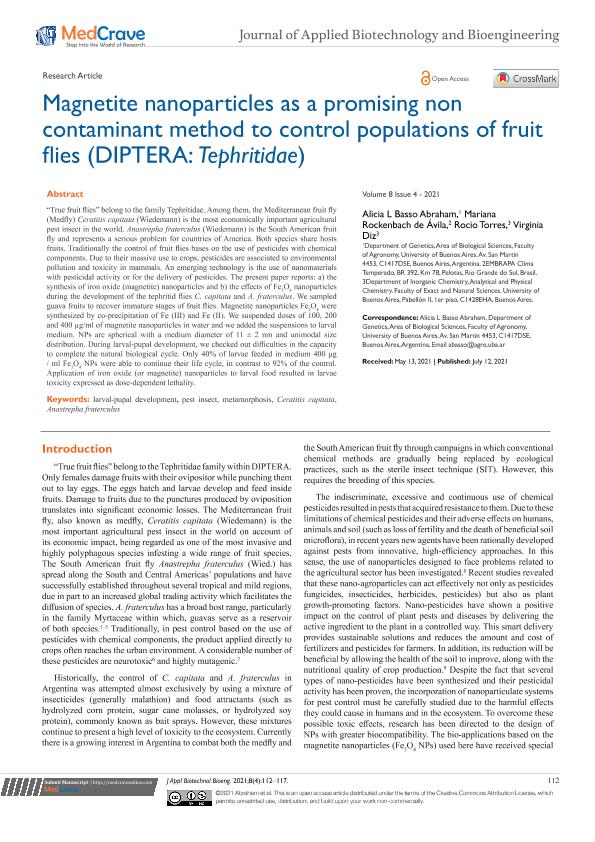Mostrar el registro sencillo del ítem
dc.contributor.author
Basso Abraham, Alicia Leonor Rufina

dc.contributor.author
Rockenbach de Ávila, Mariana

dc.contributor.author
Torres, Rocío

dc.contributor.author
Diz, Virginia Emilse

dc.date.available
2023-11-06T14:47:36Z
dc.date.issued
2021-05
dc.identifier.citation
Basso Abraham, Alicia Leonor Rufina; Rockenbach de Ávila, Mariana; Torres, Rocío; Diz, Virginia Emilse; Magnetite nanoparticles as a promising non contaminant method to control populations of fruit flies (DIPTERA: Tephritidae); MedCrave; Journal of Applied Biotechnology and Bioengineering; 8; 5-2021; 112-117
dc.identifier.uri
http://hdl.handle.net/11336/217159
dc.description.abstract
“True fruit flies” belong to the family Tephritidae. Among them, the Mediterranean fruit fly (Medfly) Ceratitis capitata (Wiedemann) is the most economically important agricultural pest insect in the world. Anastrepha fraterculus (Wiedemann) is the South American fruit fly and represents a serious problem for countries of America. Both species share hosts fruits. Traditionally the control of fruit flies bases on the use of pesticides with chemical components. Due to their massive use to crops, pesticides are associated to environmental pollution and toxicity in mammals. An emerging technology is the use of nanomaterials with pesticidal activity or for the delivery of pesticides. The present paper reports: a) the synthesis of iron oxide (magnetite) nanoparticles and b) the effects of Fe3 O4 nanoparticles during the development of the tephritid flies C. capitata and A. fraterculus. We sampled guava fruits to recover immature stages of fruit flies. Magnetite nanoparticles Fe3 O4 were synthesized by co-precipitation of Fe (III) and Fe (II). We suspended doses of 100, 200 and 400 µg/ml of magnetite nanoparticles in water and we added the suspensions to larval medium. NPs are spherical with a medium diameter of 11 ± 2 nm and unimodal size distribution. During larval-pupal development, we checked out difficulties in the capacity to complete the natural biological cycle. Only 40% of larvae feeded in medium 400 μg / ml Fe3 O4 NPs were able to continue their life cycle, in contrast to 92% of the control. Application of iron oxide (or magnetite) nanoparticles to larval food resulted in larvae toxicity expressed as dose-dependent lethality.
dc.format
application/pdf
dc.language.iso
eng
dc.publisher
MedCrave
dc.rights
info:eu-repo/semantics/openAccess
dc.rights.uri
https://creativecommons.org/licenses/by-nc/2.5/ar/
dc.subject
ANASTREPHA FRATERCULUS
dc.subject
CERATITIS CAPITATA
dc.subject
LARVAL-PUPAL DEVELOPMENT
dc.subject
PEST INSECT
dc.subject.classification
Zoología, Ornitología, Entomología, Etología

dc.subject.classification
Ciencias Biológicas

dc.subject.classification
CIENCIAS NATURALES Y EXACTAS

dc.title
Magnetite nanoparticles as a promising non contaminant method to control populations of fruit flies (DIPTERA: Tephritidae)
dc.type
info:eu-repo/semantics/article
dc.type
info:ar-repo/semantics/artículo
dc.type
info:eu-repo/semantics/publishedVersion
dc.date.updated
2023-11-06T09:59:40Z
dc.identifier.eissn
2572-8466
dc.journal.volume
8
dc.journal.pagination
112-117
dc.journal.pais
Estados Unidos

dc.journal.ciudad
Oklahoma
dc.description.fil
Fil: Basso Abraham, Alicia Leonor Rufina. Universidad de Buenos Aires. Facultad de Agronomía; Argentina
dc.description.fil
Fil: Rockenbach de Ávila, Mariana. Universidad de Buenos Aires. Facultad de Agronomía; Argentina
dc.description.fil
Fil: Torres, Rocío. Consejo Nacional de Investigaciones Científicas y Técnicas. Oficina de Coordinación Administrativa Ciudad Universitaria. Instituto de Química, Física de los Materiales, Medioambiente y Energía. Universidad de Buenos Aires. Facultad de Ciencias Exactas y Naturales. Instituto de Química, Física de los Materiales, Medioambiente y Energía; Argentina. Universidad de Buenos Aires. Facultad de Cs.exactas y Naturales. Departamento de Química Inorganica, Anal.y Qca.física. Area de Fotoquímica; Argentina
dc.description.fil
Fil: Diz, Virginia Emilse. Universidad de Buenos Aires. Facultad de Cs.exactas y Naturales. Departamento de Química Inorganica, Anal.y Qca.física. Area de Fotoquímica; Argentina
dc.journal.title
Journal of Applied Biotechnology and Bioengineering
dc.relation.alternativeid
info:eu-repo/semantics/altIdentifier/url/https://medcraveonline.com/JABB/JABB-08-00262.pdf
dc.relation.alternativeid
info:eu-repo/semantics/altIdentifier/doi/http://dx.doi.org/10.15406/jabb.2021.08.00262
Archivos asociados
